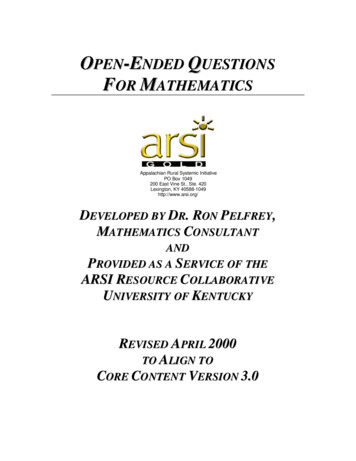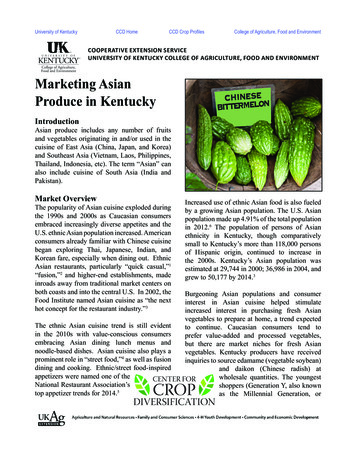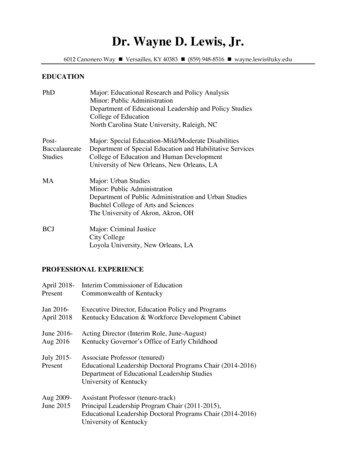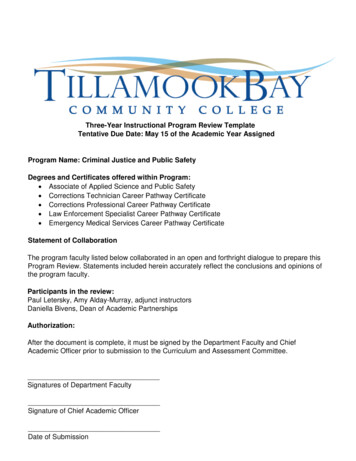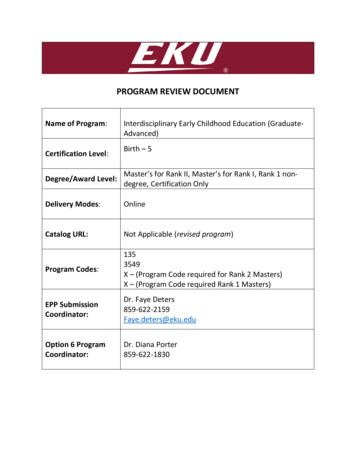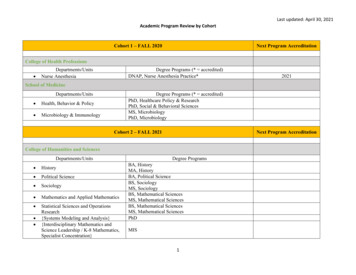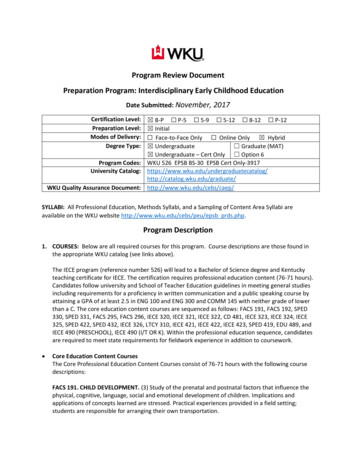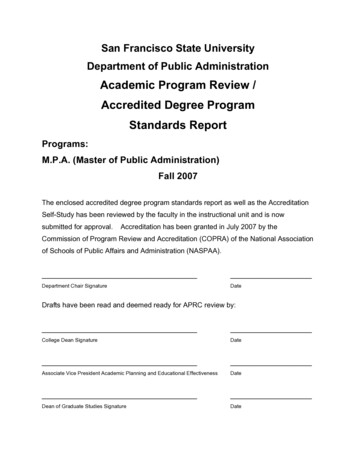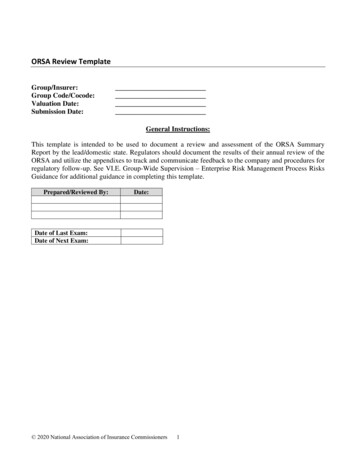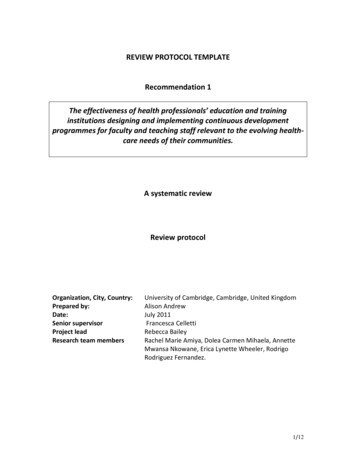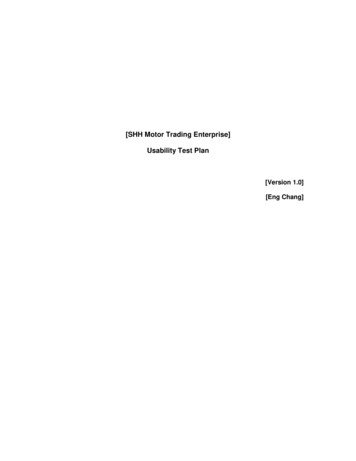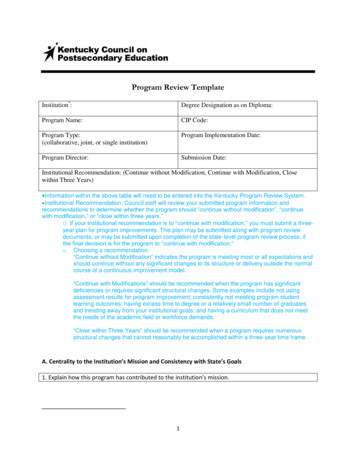
Transcription
Program Review TemplateInstitution*:Degree Designation as on Diploma:Program Name:CIP Code:Program Type:(collaborative, joint, or single institution)Program Implementation Date:Program Director:Submission Date:Institutional Recommendation: (Continue without Modification, Continue with Modification, Closewithin Three Years) Information within the above table will need to be entered into the Kentucky Program Review System. Institutional Recommendation: Council staff will review your submitted program information andrecommendations to determine whether the program should “continue without modification”, “continuewith modification,” or “close within three years.”O If your institutional recommendation is to “continue with modification,” you must submit a threeyear plan for program improvements. This plan may be submitted along with program reviewdocuments, or may be submitted upon completion of the state-level program review process, ifthe final decision is for the program to “continue with modification.”o Choosing a recommendation:“Continue without Modification” indicates the program is meeting most or all expectations andshould continue without any significant changes to its structure or delivery outside the normalcourse of a continuous improvement model.“Continue with Modifications” should be recommended when the program has significantdeficiencies or requires significant structural changes. Some examples include not usingassessment results for program improvement; consistently not meeting program studentlearning outcomes; having excess time to degree or a relatively small number of graduatesand trending away from your institutional goals; and having a curriculum that does not meetthe needs of the academic field or workforce demands.“Close within Three Years” should be recommended when a program requires numerousstructural changes that cannot reasonably be accomplished within a three-year time frame.A. Centrality to the Institution’s Mission and Consistency with State’s Goals1. Explain how this program has contributed to the institution’s mission.1
A program should adhere to the role and scope of the institution as set forth in its mission statement andas complemented by the institution’s strategic plan2. Explain how this program has contributed to the economic and social welfare goals of HB1 asdelineated in the statewide postsecondary education strategic agenda – Stronger by Degrees.There should be a clear connection between the program and the state’s postsecondary education goals.The state’s strategic plan for postsecondary education focuses on four areas. Please choose whicharea(s) your proposed program relates to along with which policy objective(s) that your proposed programaddresses.Explain the contribution(s) the program makes to these areas and policy objectives. College readiness–Will the program increase the number of college-ready Kentuckians enteringpostsecondary education? Will it increase the number of college-ready GED graduates? Will it increasethe effectiveness of Kentucky’s K-12 teachers and school leaders? Student success–Does this program increase high-quality degree production and completion rates andclose achievement gaps, particularly for lower-income, underprepared, and underrepresented minoritystudents? Does this program decrease financial barriers to college access and completion? Research, economic, and community development--Does this program increase educational attainmentand quality of life in Kentucky communities through regional stewardship, public service, and communityoutreach? Efficiency and innovation--Does this program increase academic productivity through programinnovations? Does this program maximize the use of postsecondary and adult education resources?3. Explain how this program aligns with the statewide postsecondary education strategicimplementation plan.In your answer, focus on how this program aligns with one or more action steps included in the strategicimplementation plan.B. Program Quality and Student Success1. Briefly describe assessment results from the past five years and explain how these results have beenused to make improvements to the program.1. Briefly describe assessment results from the past five years and explain how these results have beenused to make improvements to the program.In your answer, please address all of the following: State all student learning outcomes of the program. Explain how each of these program-level student learning outcomes were evaluated.O Include all direct and indirect assessment methods used to evaluate this program.O Explain which student learning outcome(s) were assessed by each met and howfrequently each method is administered.O Include the benchmarks and/or targets identified for the program. Briefly summarize assessment results related to each SLO. Explain how assessment results have been used to make improvements to the program.2
Explain the program’s measures of teaching effectiveness and what efforts to improve teachingeffectiveness have been pursued based on these measures.2. Describe any external awards or other recognition of the students, faculty, and/or program over thepast five years.In your answer, please: Describe any awards from disciplinary associations, nonprofit organizations, governmental agencies, orany other external entities that recognize the accomplishments of this program. Describe accomplishments related to student work, faculty teaching and research, and other elements ofyour program. Describe any specialized accreditation attained by the program.3. a. Number of hours required to complete this program:The number of hours does not include general education requirementsb. Include the average actual time to degree for this program in the table below.Average actual time to degree refers to the average number of years it takes for a group of studentsgraduating from a program in a particular year to graduate from the institution.This is not the same as the institution’s actual time to degree. It refers only to the program under review.Average actual time to degree should be calculated for two populations of students –native students andtransfer students. The calculation for native students includes time spent on developmental educationcourses but does not include the time a student was enrolled in dual credit courses.If a student stops out of school for more than two years, he or she is considered a returning student andis not counted in the calculation.For the calculation for transfer students, the starting point is when the student officially transfers to yourinstitution.(KCTCS institutions should address only native students.Four-year institutions may count students that move from an associate degree program to abaccalaureate degree program at their institution as a transfer student.)c. Include the average actual credit to degree is for this program in the table below.Average actual credit to degree refers to the average number of credit hours earned by the group ofstudents within the program graduating in a particular year. These credits include transfer credits anddevelopmental education credits. (KCTCS institutions should address only native students.)Year:Average actual time to degreeYear:Express innumberof yearsAverage actual credit to degree4. a.Describe employer satisfaction with program graduates.3Year:Year:Year:
b.Include survey results, focus group results, advisory board results, or other evidence ofemployer satisfaction with program graduates.Include any recommendations from employers on how to improve the program to meetthe needs of the community.AA/AS programs may also describe focus group, survey, or other evidence gatheredfrom baccalaureate institutions to which your students have transferred.Describe graduating students’ and alumni satisfaction with program. Include survey results, focus group results, or other evidence of alumni and graduatingstudents’ satisfaction.Include any recommendations from alumni on how to improve the program.5. Job placement, transfer, and graduate school admission.Include requisite information in the table(s) below.Associate of Arts and Associate of Science degree programs must address 5b.All other Associate degree programs must address 5a. Bachelor’s and Master’s degree programs mustaddress both 5a and 5c.Doctoral degree programs must address 5a.a. Include job placement data for program graduates in the tables below. Describe the types of jobs graduates have secured. Are the jobs directly related to thecontent of the program? Are the jobs indirectly related to the content of the program?What percentage of students have found employment in your area of geographicresponsibility? In Kentucky? Outside of Kentucky?Note any employers who have offered jobs to multiple graduates.Provide examples of students who earned distinction in the field of study under :Number of graduatingstudents who soughtemploymentPercentage of students whosought employmentNumber of graduatingstudents who gainedemploymentPercentage of graduatingstudents who gainedemploymentYear:4
Percentage ofstudents employed inthat typeType of Job:Type of Job:Type of Job:Year:Year:Year:Year:Year:Percentage ofstudents findingemployment inarea of geographicresponsibilityPercentage ofstudents findingemployment inKentuckyPercentage ofstudents findingemploymentoutside of Kentuckyb. Include transfer data for program graduates. (AA/AS Programs only)Year:Year:Year:Year:Year:Number of graduatingstudents who transferredto a four-year institutionPercentage of graduatingstudents who transferredto a four-year r:Year:Year:Percentageof studentswhopursuedthat majorMajor:Major:Year:Institution:Percentageof studentswhotransferredto this5
institution.Institution:Institution:c. Include graduate school admission data for program graduates. If bachelor’s degree, note how many and what percentage of students pursue a graduate orprofessional degree in the field or in related fields. Include the names of graduate schools towhich the students were accepted.If master’s degree, note how many and what percentage of students pursue a doctorate in thefield or a related field. Include the names of graduate schools to which the students wereacceptedYear:Year:Year:Year:Year:Number of graduatingstudents who soughtgraduate school admissionPercentage of graduatingstudents who soughtgraduate school admissionNumber of graduatingstudents who attainedgraduate school admissionPercentage of graduatingstudents who attainedgraduate school admission6. Does this program lead to licensure or certification? If yes, then include students’ pass rates onlicensure/certification exams.Name of Exam:Year:Year:Year:Year:Year:Pass RateC. Program Demand/Unnecessary Duplication1. Provide the number of students enrolled, number of graduates, and credit hour production overthe past five years (includes summer, fall, and spring). Credit hour production refers to the number of credit hours produced by program faculty.Number of enrollees and degrees conferred includes totals from summer, fall, and r:
Degrees ConferredCredit HourProduction2. Are there similar programs at other public institutions in the state? YESNOA similar program is defined as a program with the same or closely related CIP code at the samedegree level.Programs are not considered duplicative if they serve a different student population than existingprograms, or if the curriculum is distinctive from that of existing programs at other Kentucky publicinstitutions.a. If yes, then explain how the curriculum of this program is different from existing programs atother institutions or that access to these programs is limited at the other institutions.b. If yes, describe specific collaborative opportunities your program is pursuing, or can pursue,with these existing programs. In your explanation, describe how the collaboration will increasethe effectiveness and efficiency of each program.D. Cost and Funding1. Note the program’s student credit hour per instructional faculty FTE for the past five years (for thefall and spring semesters only).a. Please explain your institution’s definition of instructional FTE. Student credit hour per instructional faculty FTE is defined as credit hours taught by programfaculty in a unit, department or discipline, divided by the number of instructional FTE (as definedby the institution) of those program faculty.Include your institution’s definition of instructional FTE.Year:Year:Year:Year:Year:Student credit hourper instructionalfaculty FTE2. Describe any extramural funding that program faculty have attracted over the last five years. Extramural funding includes any funds from outside the postsecondary institution that is used tosupport the program. Possible sources of funds include governmental agencies (local, state, and7
federal), businesses, private foundations, or individuals.In addition to the table, include narrative about the extramural funding, including its purpose, itsduration, the total amount of funding over the life of the grant or contract, and any other relevantinformation.Sources of ExtramuralFundingSource 1:Year:Year:Year:Year:Year:Source 2:Source 3:Source 4:Source 5:E. Additional Information1. Please provide any other information that explains the importance of this program to your campus orcommunity. Include any additional information to explain academic, social, economic, or other contributionsthe program makes to your campus or area of geographic responsibility.Include any clarification of data points provided above. For example, if the program hasgraduated many double majors, and you believe that this has affected metrics such as time todegree, please explain that here.8
Program Review Template Institution*: Degree Designation as on Diploma: Program Name: CIP Code: Program Type: (collaborative, joint, or single institution) Program Implementation Date: Program Director: Submission Date: Institutional Recommendation: (Continue without Modification, Continue with Modification, Close within Three Years) Information within the above table will need to be entered .
